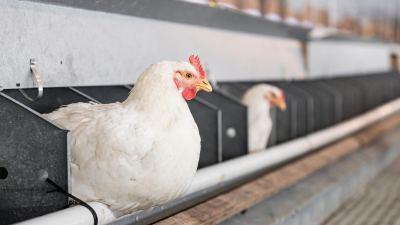Eggs in a (nut) shell

White eggs vs. Brown eggs
Identical in nutrient value, the only real difference between the two is the breed of hen they come from. White shelled eggs are typically produced by hens with white feathers, while brown shelled eggs are typically from hens with brown feathers.
Conventional
Eggs laid by hens living in cages with access to feed, water, and security. The cages serve as nesting space and can enhance production efficiency. In this type of hen house, the birds are more readily protected from the elements, disease and natural and unnatural predators.
Organic
To produce eggs that can be labeled as ‘organic’, hens are fed rations with ingredients that were grown without most conventional pesticides, fungicides, herbicides or commercial fertilizers. The United States Department of Agriculture (USDA) has specific rules to define organic production and prohibits the use of the term organic on packaging of any food product not produced in accordance with its rule. According to USDA, the organic label does not indicate that the product has safety, quality or nutritional attributes that are any higher than conventionally raised product.
Vegetarian Diet
Hens are fed a special feed containing ingredients of plant origin only. The nutrient content of these eggs is the same as that of conventional eggs.
Omega-3-Enriched
Many farmers believe specialty eggs, particularly omega-3 enriched eggs, will be the next big thing in the functional food market, but not all omega-3’s are created equal. There are three major omega-3 fatty acids with distinct health benefits: docosahexaenoic acid (DHA), eicosapentaenoic acid (EPA) and alpha-linolenic acid (ALA).
ALA is often promoted as omega-3 in foods, largely due to its low cost and abundant availability fed to layers as linseed. While this serves as an energy source, its relative inability to be converted to DHA means the animal and consumer receive minimal health benefits.
EPA is a long-chain omega-3 that is important for cardiovascular function and inflammation reduction. EPA found in eggs is typically sourced from fish oil and fish meal fed to the hens.
DHA is vital in human diets, playing an important role during pregnancy and early infant development. In children, DHA is linked to improved learning outcomes and behavior. In adults, DHA has been associated with lower rate of cardiovascular disease and improved cognitive health. DHA in eggs can be found alongside EPA sourced from fish products, but can also be supplied by algae that are naturally high in DHA. Omega-3-enriched eggs laid by hens fed an algae-enriched diet produce eggs that are suitable for an ovo-vegetarian diet.
Vitamin- or Mineral-Enriched
These eggs are from hens fed a nutritionally-enhanced diet with higher levels of certain nutrients (eg. selenium, vitamin E, folate, lutein, vitamin B-6, vitamin B-12). As a result, these eggs contain higher amounts of select nutrients.
Free-Range
Eggs produced by hens that have access to the outdoors in accordance with weather, environmental or state standards. In addition to consuming a diet of grains, these hens may forage for wild plants and insects and are sometimes called ‘pasture-fed’ hens. They are provided floor space, nesting space and perches.
Cage-Free
Eggs laid by hens at indoor floor operations, sometimes called ‘free-roaming’. The hens may walk freely in a building, room or open area, usually in a barn or poultry house, and have unlimited access to fresh food and water, while some may also forage for food if they are allowed outdoors. Cage-free systems vary and include barn-raised and free-range hens, both of which have shelter that helps protect against predators. Both types are produced under common handling and care practices, which provide floor space, nest space and perches.
Natural
Under USDA regulations, a “natural” product has no artificial ingredients, coloring ingredients, or chemical preservatives, and is minimally processed, just enough to get it ready to be cooked.
No Hormones Added
No artificial or added hormones are used in the production of any poultry in the United States. Regulations of the Food & Drug Administration (FDA) prohibit the use of such hormones. Therefore, any brand of eggs can be labeled “raised without hormones”, however, any package of eggs with that type of label must also have a statement that no hormones are used in the production of any poultry.
“Raised without Antibiotics” or “Antibiotic-Free”
“Raised without antibiotics” on a carton of eggs indicates that during the period while hens are laying eggs, there was no use of products classified as antibiotics for animal health maintenance, disease prevention or treatment of disease. Flocks producing certified organic eggs must be antibiotic-free by regulation. Flocks producing conventional eggs may use FDA-approved antibiotics and must comply with FDA levels of use and other restrictions. FDA regulations assure that antibiotic residues do not occur in the egg itself.
Enriched Colony
A production system that contains adequate environmental enrichments to provide perch space, dust bathing or a scratch area(s), and nest space to allow the layers to exhibit inherent behavior. Enriched colony systems are American Humane Certified.
Sources: United States Poultry and Egg Association, American Egg Board















